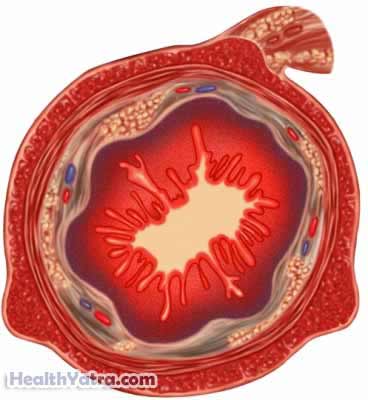Definition
Whipple’s disease is a rare infectious disease. It is caused by a bacterium namedTropheryma whippleii.
Causes
Whipple’s disease is caused by a specific type of bacteria. This bacterium causes abnormal changes on the wall of the small intestine. These changes disrupt the villi. Villi are tiny, finger-like structures that stick out from the wall of the intestine to help absorb nutrients. As a result, some nutrients are not absorbed properly and do not reach the rest of the body.

Risk Factors
There is no evidence that Whipple’s disease is passed from person to person. But, there is some evidence that the bacteria may be present in people who are healthy. This suggests that the few people who develop the disease may have an abnormal response to the bacteria. Some people with Whipple’s disease may have a genetic defect that makes them more likely to develop the disease. Whipple’s disease occurs mainly in middle-aged men.
Symptoms
This disease can affect many parts of the body. The small intestine is the main organ affected. Symptoms usually begin slowly and occur in stages. The first stage includes:
- Pain in the joints (in 90% of cases)
- Fever
The disease is usually not diagnosed until several years later when additional symptoms may develop. These include:
- Pain and bloating in the abdomen
- Diarrhea
- Fatty foul-smelling stools
- Bleeding from the intestines
- Weight loss
- Weakness
- Fatigue (often from anemia)
- Cough and chest pain
- Increased skin pigmentation (in 50% of cases)
- Swollen lymph glands
If the disease is not treated, this second stage may last for a number of years. Then, more severe symptoms may occur due to the lack of nutrients reaching different parts of the body. Symptoms may occur in any part of the body, but most likely the heart, nervous system, brain, lungs, eyes, or skin. If the disease still is not treated, it usually causes death in this third stage.
Diagnosis
The doctor will ask about your symptoms and medical history. A physical exam will be done.
- Your doctor may need to test your bodily fluids, tissues, and waste products. This can be done with:
- Blood tests
- Stool tests
- Polymerase chain reaction (PCR) test
- Biopsy
- Your doctor may need pictures of your bodily structures. This can be done with CT scan.
Treatment
Taking antibiotics can cure Whipple’s disease. Often, a combination of antibiotics is used. These drugs kill the bacteria that cause the disease. Your doctor will work with you to find the best types and doses for you. Antibiotics may be given orally or by IV.
If you have a more severe case of Whipple’s disease, you may also need intravenous antibiotics, fluid, and electrolyte replacement when you begin treatment. Electrolytes are salts and other substances in your body fluid that your heart and brain need to work properly. You may also need to take supplements of certain vitamins and minerals that your body is not absorbing normally on its own. These may include:
- Iron
- Folate
- Vitamins A, B12, D, E, and K
- Calcium
- Magnesium
Symptoms usually go away after a few weeks to a few months on antibiotics. Your doctor may check your progress with the PCR test to see if any of the disease-causing bacteria are left. However, you will still need to take antibiotics for 1-2 years to prevent the disease from returning.
Prevention
Currently, there is no known way to prevent Whipple’s disease.
